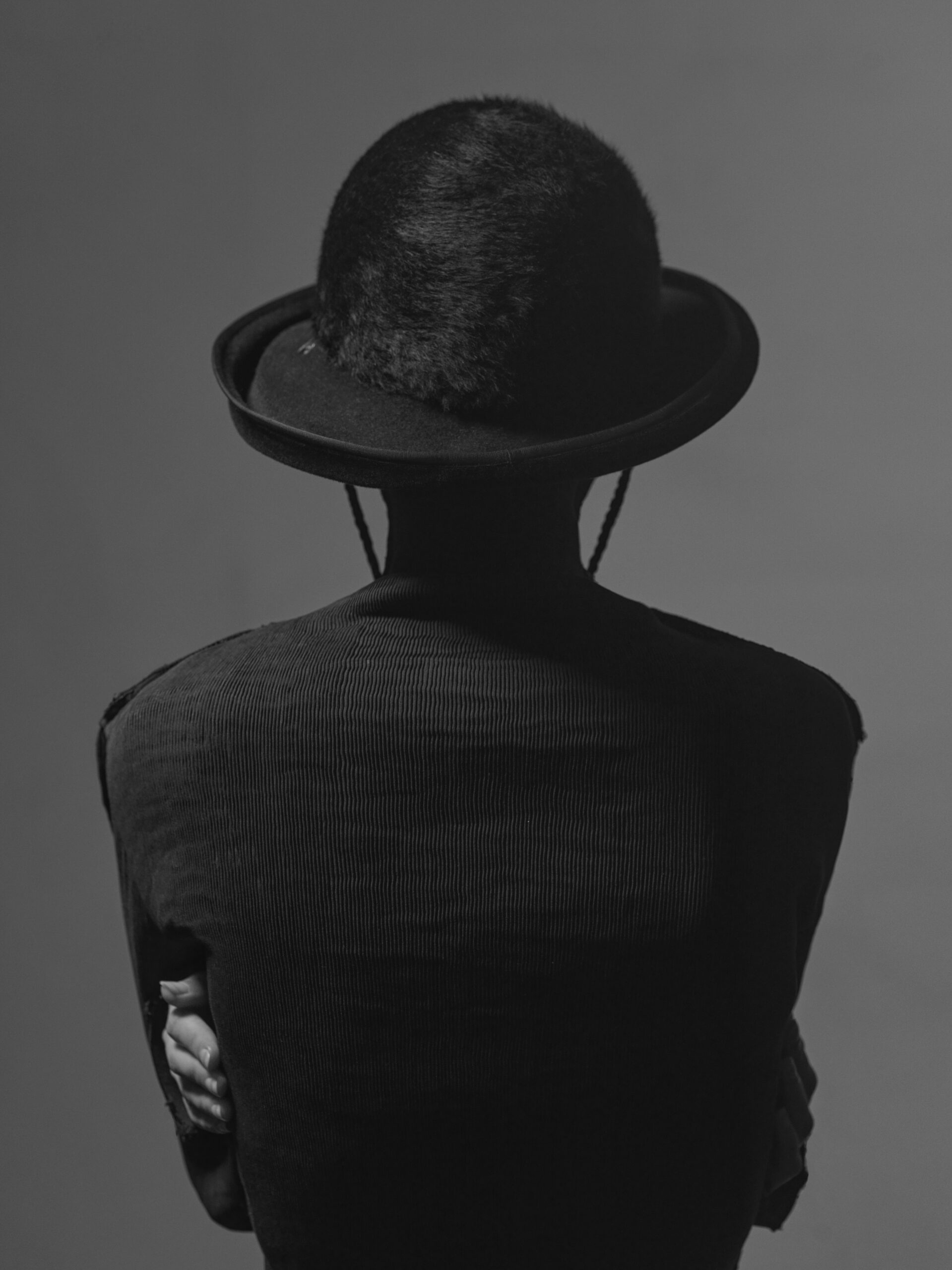HIGH LINE
#003 1/2
2024.06.03
10周年企画『Thanks and then.』最終章
「不変の価値」を未来へつなぐ “HIGH LINE” とは 1/2
「KIJIMA TAKAYUKI」とブランドを冠してから、早10年。昨年9月以降、縁ある様々なブランドとのコラボレーションを発表してきた10周年記念プロジェクト『Thanks and then.』最後に登場する “HIGH LINE”について、改めてその成り立ちを語る。
A decade has passed since we adopted the KIJIMA TAKAYUKI brand name. Since last September, we have been introducing collaborations with various affiliated brands for our 10th anniversary project “Thanks and then.” Now, we will discuss the origins of “HIGH LINE,” the final segment of this project.
2013年に前身のブランドから自身の名へ改名し、東京・パリで年2回展示会を行ってきたKIJIMA TAKAYUKIは、現在3つのラインから構成されている。
1つは、KIJIMA TAKAYUKIの主軸「インライン」。そのシーズンごとの空気感を独自の視点で掘り下げ、『スタイリングで生きるデザイン』をコンセプトに、“ファッションアイテム”としての帽子に重きを置く。2つ目は、歴史やプロダクトに敬意を払い、現代的な解釈で再構築していく、いわゆる“アップサイクリング”されたアイテムを作り上げる“answer It”。そして3つ目が、 “HIGH LINE”。時代に左右されない『普遍の価値』を追求し、伝統的な技術を現代的なデザインの解釈でコレクションに落とし込む。デザインから型の制作・素材決めまで木島本人が行ない、一職人として、現在も量産を続けている。
2017年からHIGH LINEを新たにローンチした事について、「ハイエンドの技術があってこそのKIJIMA TAKAYUKIだということを伝えていきたい。それには、HIGH LINEが必要だというのを遅ればせながら思ったのがきっかけ」だと木島本人は語る。
In 2013, KIJIMA TAKAYUKI adopted his own name, transitioning from its former brand, and has since been holding biannual exhibitions in Tokyo and Paris. The brand now consists of three lines.
The first is KIJIMA TAKAYUKI’s main line, “Inline.” Delving into the atmosphere of each season with a unique viewpoint, it emphasizes “designs that live in styling” and focuses on hats as fashion items. The second line, “answer It,” honors history and products by reinterpreting them with modern sensibilities, producing “upcycled” items. Lastly, the third is “HIGH LINE.” It aims for “timeless value” beyond trends, blending traditional techniques with modern design interpretations in its collections. Kijima personally oversees everything from design to pattern making and material selection, and continues to produce in large quantities as an artisan.
Looking back at the introduction of “HIGH LINE” in 2017, Kijima notes, “I want to express that the essence of KIJIMA TAKAYUKI lies in high-end techniques. I realized, though somewhat belatedly, that ‘HIGH LINE’ was essential for this.”
HIGH LINEの帽子作りは、すべて代官山直営店の地下に所在するアトリエの中で行う。
あまり知られていないが、実はこれはかなり珍しいことである。専門的な技術を必要とするため、その多くが帽子工場に発注して生産するのが通常だ。このアトリエには、帽子作りに必要なすべてが揃っている。
All “HIGH LINE” hats are made in the atelier in the basement of the Daikanyama flagship store.
Little known fact: this is actually quite unusual. The specialized techniques required mean that most hats are typically manufactured in factories. The atelier is fully equipped with everything needed for hat-making.
そもそも木島には、オートモード*1の技術を日本に持ち帰り、皇室などの帽子を製作したデザイナーの第一人者である故平田暁夫氏*2に1990年から1995年間師事していた背景がある。ヨーロッパの伝統的なオートモードの技術を習得した木島は、それを途絶えさせない使命感にかられている。
「帽子作りの伝統文化はヨーロッパから始まった。それに敬意を払いながら、遠く離れた日本にもその技術を受け継ぎながら、帽子作りしている人がいることを世界に伝えていきたい」と木島本人が語る。
「50年以上前から受け継がれる製法を守る老舗ブランドに対する意識として」と前置きをしながら、「伝統では太刀打ちできない中で、技術や歴史の中で受け継がれる製法を現代にアップデートさせること、その精神性を引き継ぐことが、僕のようなブランドがやれること」。
Originally, Kijima studied under the late Akio Hirata2, a pioneer designer known for bringing haute couture1 techniques to Japan and creating hats for the imperial family, from 1990 to 1995. Having mastered traditional European haute couture techniques, Kijima feels a strong sense of duty to keep them alive.
“The tradition of hat-making began in Europe. By honoring that heritage, I want to convey to the world that there are artisans in faraway Japan who have inherited these techniques and continue making hats,” Kijima explains.
Kijima first explains, “As a brand conscious of preserving techniques passed down for over 50 years,” and continues by saying, “in an era where tradition alone can’t compete, what brands like mine can do is update these techniques inherited through history and craftsmanship for the modern day, and carry forward that spirit.”
*1:洋服でいうオートクチュールのこと。採寸はもちろんのこと、デザインから素材決めまで、すべてをオーダーメイドで作る。
*2:1960年代に渡仏してオートモードの巨匠ジャン・バルテ氏に師事。オートモードの技術を日本に持ち帰り、皇室などの帽子を製作していた。
*1: This refers to haute couture in clothing, where everything is custom-made, from measurements to design and material selection.
*2: In the 1960s, he traveled to France and apprenticed under Jean Barthet, a haute couture master. He then brought these techniques to Japan, where he crafted hats for the imperial family, among others.
使用しているのは半世紀以上前から受け継がれるブレードミシン。手先指の感覚や、スピードを調整する足の感覚のみを頼りにサイズ別に縫い上げる。HIGH LINEで使用するブレードは高密度のためにブレードミシンの工程で完璧に縫わなければならず、熟練した技術で丹念に縫い上げていく。オリジナルの型で材料を成形していく「型入れ」の工程では、それぞれの材料が持つ特性を見極めながら丁寧に形にしていく。
「決して派手なことはしないけれど、一目ではわかりづらい所にこだわってしまう」と語る。現行では生産されない稀少なデッドストックの材料をも用いながら、手作業の時間と労を惜しまず、伝統に縛られない現代的な解釈を落とし込むことを重要視している。
「30年以上の帽子作りのなかで培ってきた視線で素材もバランスもベストな黄金比を追求している。ことHIGH LINEにおいては、シーズンの流行り廃りに左右されないものを作っています。そこの中にちゃんと文化として帽子も最高峰の伝統技術を途絶えさせないような新しい動きをしていかないといけないと、ある意味伝統的なシーンに対して警鐘を鳴らすような役割もある」と50年単位のファッションにおける未来を見据える。
Our tools include braid sewing machines that have been passed down for over 50 years. Relying solely on the tactile sense of our fingers and the foot control for speed adjustments, we sew each piece to size. Due to their high density, the braids used in “HIGH LINE” must be perfectly sewn during the braid sewing process, which requires expert skill and precise workmanship. During the “molding” process, where materials are shaped using original molds, we carefully form each piece while assessing the unique characteristics of the materials.
“We never do anything flashy, but we pay great attention to details that are difficult to notice at first sight,” he explains. We place great importance on incorporating contemporary interpretations without being bound by tradition, using rare deadstock materials that are no longer produced, and sparing no time or effort in handcrafting.
“Through over 30 years of hat-making, we have cultivated an eye for pursuing the best golden ratio in materials and balance. For ‘HIGH LINE,’ we focus on producing pieces that remain unaffected by seasonal fads. In doing so, we must ensure that the culture and pinnacle of traditional techniques in hat-making are not lost, driving new movements that in some way serve as a wake-up call to the traditional industry,” he asserts, looking ahead to the future of fashion over the next 50 years.
過去に敬意を払いながらもレガシーに引っ張られすぎることなく、今の時代感覚で帽子づくりに置き換えること。そしてファッションのなかにおける帽子の立ち位置を確立するという文化作りに注力している。「ファッションは生き物だからこそ、毎シーズン、新素材や縫製技術の提案すべきもの。時代の進化に伴って、職人も同じことを繰り返すだけでなく、新しいことにチャレンジし続けるアティチュード。これがこれからの職人像だと僕は思う」と木島は語る。
次回後編では、10周年企画『Thanks and then.』を記念しリリースされる4ピースの詳細、そして今後の展望についてさらに詳しく掘り下げる。
“We honor the past without being excessively tied to legacy. We adapt hat-making to the current times, focusing on establishing the cultural significance of hats within fashion. Fashion is a living entity; thus, every season, we should introduce new materials and sewing techniques. As times evolve, artisans should not merely repeat the same practices but continuously challenge themselves with new ideas. I believe this embodies what future artisans should aspire to be,” Kijima explains.
In the next part, we will provide a thorough look at the four pieces released for the 10th anniversary project “Thanks and then.” and discuss future developments in more depth.
Text & Translation : Hiroyoshi Tomite











